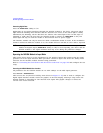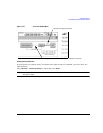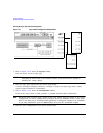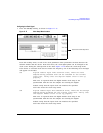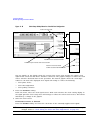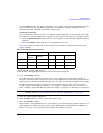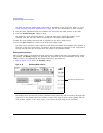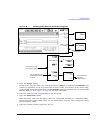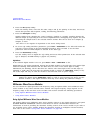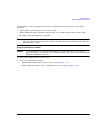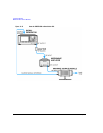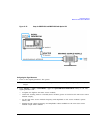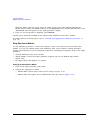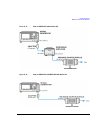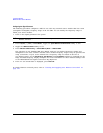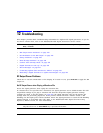
236 Chapter 11
Peripheral Devices
Millimeter-Wave Source Modules
6. Press the More (1 of 2) softkey.
From this softkey menu, select the bit order, swap I and Q, the polarity of the data, and access
menus that provides data negation, scaling, and filtering parameters.
7. Press the
Data Negation softkey.
Negation differs from changing the I and Q polarity. Applied to a sample, negation changes the
affected sample by expressing it in the two's complement form, multiplying it by negative one, and
converting the sample back to the selected numeric format. This can be done for I samples, Q
samples, or both.
The choice to use negation is dependent on the device being tested.
8. To access I/Q scaling and filter parameters, press
Return > N5102A Off On to On. This will invoke the
real time Custom format in the PSG baseband generator. This is needed to set the filter
parameters when Pre-FIR Samples is selected as the data type.
9. Press the
Baseband Setup softkey.
Use this softkey menu to adjust the I/Q scaling and access filter parameters. If the selected data
type is Samples, the
Filter softkey is grayed out (inactive).
Digital Data
If the N5102A digital module is not on, press
Return > Return > N5102A Off On to On.
Digital data is now being transferred through the N5102A module to the PSG. The green status light
should be blinking. This indicates that the data lines are active. If the status light is solidly
illuminated (not blinking), all the data lines are inactive. The status light comes on and stays on
(blinking or solid) after the first time the N5102A module is turned on (
N5102A Off On softkey to On).
The status light will stay on until the module is disconnected from its power supply.
NOTE If changes are made to the baseband data parameters, it is recommended that you first
disable the digital output (
N5102A Off On softkey to Off) to avoid exposing the device and the
N5102A module to the signal variations that may occur during the parameter changes.
Millimeter-Wave Source Modules
You can extend the signal generator’s RF frequency using an Agilent 8355x series millimeter-wave
source module or any other external source module. The output frequency range depends on the
frequency range of the mm-wave source module. This section contains the following procedures:
• Using Agilent Millimeter-Wave Source Modules
• Using Other Source Modules
Using Agilent Millimeter-Wave Source Modules
The Agilent 8355x series millimeter-wave source module connects to the signal generator’s rear panel
SOURCE MODULE INTERFACE connector and allows for direct communication between the
instruments as well as providing for automatic leveling control of the source module. If you want to
use an 8355x series source module without the automatic leveling or multiplier selection features,
then refer to the section “Using Other Source Modules” on page 240.



